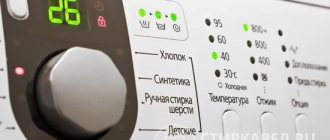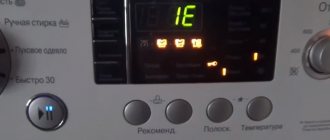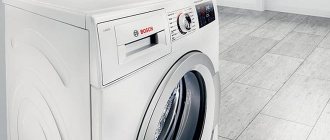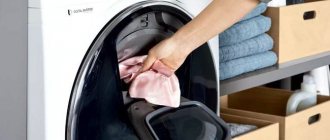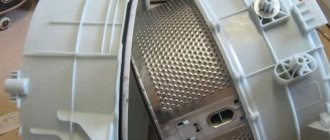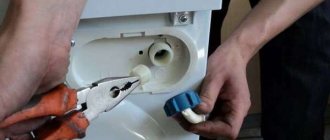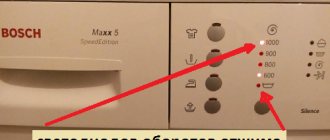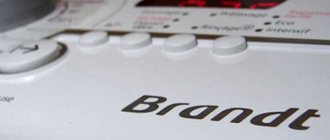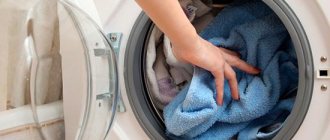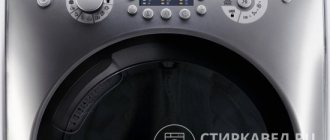We will make your task easier and save time on searching by offering you ready-made manuals and instructions for repairing washing machines yourself. The source for creating the material was the rich practical experience in repair of our specialists.
Gone are the days when a washing machine was a luxury item that not everyone could afford. Today it is a familiar and necessary household item in every home.
Therefore, when this device breaks down, it is felt immediately and requires an immediate solution. In such a situation, of course, you can call a washing machine repairman who will solve all your problems, albeit for a lot of money. Or you can try to figure out the reasons for the breakdown and try to repair the washing machine without VM with your own hands.
To make it easier to cope with this task on your own, let’s first understand the structure and operating principle of washing machines.
Master's Tool
Many of those who have had the opportunity to call a repair specialist to their home have witnessed a scene in which a repairman, using only an “arsenal” that fits into a small suitcase, easily disassembles the device and replaces the failed part. An experienced specialist knows exactly what to take with him on a call and rarely makes mistakes.
All the tools that are in the treasured suitcase can be divided into standard and special. The first group is a classic locksmith set. Regarding the latter, these are various mechanisms and devices that are necessary to perform specific operations. Such a tool can be bought in specialized stores or made independently.
Basic repairman kit
This tool is necessary for those who do not plan to engage in professional maintenance of household appliances, but intend to fix minor breakdowns of their own washing machine with their own hands. Most often, a similar set is already available in a home workshop or garage.
Screwdrivers
There is hardly any need to explain why a screwdriver is needed; it is used to unscrew screws that have corresponding grooves or recesses in the heads. To repair washing machines, you will need several pieces of different sizes and shapes. The most popular types of working tools are:
- flat;
- cruciform;
- star.
A good solution for a home workshop would be a screwdriver with replaceable blades. It is functional and takes up little space.
Set of wrenches
Using wrenches, unscrew the nuts and unscrew the hex head screws. To repair a washing machine, you don’t need to buy an expensive set; it’s better to choose several working wrenches, based on the fasteners used in a particular model.
Pliers and pliers
This tool is indispensable in cases where you need to firmly clamp, hold, or bend something. Depending on the task at hand, large pliers or pliers are used, often with a narrow and elongated working part.
It would also be a good idea to purchase round nose pliers. They are convenient for removing springs, and with their help it is easy to make a loop from steel wire.
Auxiliary tool
It is convenient to work with wires using tweezers. It’s worth purchasing at least one, or better yet several in different sizes and shapes. Repairing the electrical component of a washing machine is impossible without a sharp knife; sometimes scissors may be required.
To ensure maximum ease of use, you should stock up on a mirror with a long handle. You can buy a ready-made one, but it is much easier to make it yourself, for example, from a used bicycle or motorcycle mirror.
A flashlight is a must. For those who plan to carry out repairs only in the house, a portable lamp is enough. In any case, the light source must be bright and have a reflector that allows you to illuminate the desired area.
Among other things, during repairs of any level of complexity you cannot do without the following:
- hammer (regular and wooden);
- metal ruler;
- hacksaw for metal.
A useful thing in case of repairs involving complete or partial disassembly of the washing machine will be a small magnet attached to the end of a telescopic pointer or radio antenna. With its help, it is easy to remove screws, nuts, and small parts that have fallen inside the washing machine body.
Tools and accessories for professionals
“Experienced” craftsmen who have long been involved in “reanimating” equipment are not limited to a minimum set of tools for repairing washing machines. The scope of work can be completely different: from a banal replacement of a sealing collar to troubleshooting problems in the main control module. That is why professionals need devices that can cope with any, even the most specific task. In the specialist’s bag, along with the already mentioned list, there may be:
- soldering iron;
- powerful flashlight or portable lamp;
- small gas burner;
- a long rod with a mirror at the end (allows you to inspect hard-to-reach areas of the machine);
- pliers used for pressing contacts into connectors;
- long metal ruler;
- multimeter for measuring the resistance of the main elements of the system;
- magnet;
- screwdriver with indicator;
- puller for SMA bearings;
- wooden or rubber mallet;
- screwdriver;
- drill.
By collecting the maximum set of tools, you can cope with almost any breakdown in the system. The repairman can eliminate some defects directly at the customer’s home, taking with him a complete “suitcase”; for certain types of work, it is necessary to transport the equipment to a workshop, where the equipment can be checked with special instruments.
Set of tools for working with electricity
Since a washing machine is primarily an electrical appliance, repairing it cannot be done without a small set of electrician tools. To solder circuit elements, you will need a soldering iron with solder. Since the wiring fragments are connected to each other using connecting blocks, special pliers will be required. It’s not difficult to buy such a tool, but at home you can get by with a simple homemade product of a similar purpose. This is a fairly simple device; outwardly it looks like a metal rod to which the working part (a plate with cuts in the shape of a block) is soldered or welded.
A multimeter will be an indispensable tool when repairing the electrical part of a washing machine. It is not necessary to buy a professional device; a simple household device is enough. He will help:
- detect a broken wire;
- make sure the heating element is working;
- check the motor windings;
- “ring” the pump circuit;
- check the temperature sensor;
- identify failed elements of the control module.
A multimeter is the first device that is needed if the washing machine “refuses to start.” With its help, it is easy to check the presence of voltage in the outlet and at the input to the device.
Tips for beginners
If, having assessed the breakdown that occurred with the automatic machine and your own strength, you decided not to take the equipment to a workshop, but to carry out the repairs yourself, study the basic recommendations for beginners. Practical advice will help you avoid wasting your free time and avoiding offensive mistakes.
- Take your time, think about all upcoming actions. If you see a certain error code on the display, you should not immediately start disassembling the unit. Evaluate the appearance of the washing machine, check its main functions: how the machine draws and drains water and spins clothes. Spin the drum by hand and listen to the noise made by the equipment.
- Disconnect the equipment before work. Safety must come first. Be sure to unplug the power cord from the outlet! Also, handle the already disassembled device carefully - after removing the walls of the case, sharp corners may be exposed, which are very easy to cut yourself on.
- Before moving the washer, make sure that the drain and inlet hoses do not break. The length of the tubes used to connect the machine to the water supply and sewerage must be sufficient for movement. If you need to tilt the unit, do it as carefully as possible to avoid the washer suddenly falling on its side.
If after diagnostic measures you have identified the cause of the machine malfunction, proceed to repair. It is necessary to repair only the part that has failed. All other elements that are functioning at full capacity should not be disassembled and disconnected, otherwise you can harm the “home assistant” even more. Upon completion of the repair, check the reliability of the connection of the hoses to the house communications, plug the machine into the network and make sure that the washing machine is working.
Special tool
Most often, the above is quite sufficient, but sometimes specific devices are required. Anyone who is thinking about what tools are needed in a home workshop can be advised to stock up on a set of running pullers and special pliers for removing spring clamps. It will definitely not be possible to carry out a number of repair work without these devices.
A common cause of major repairs is bearing failure. This is a difficult situation. To replace it, you will need to completely disassemble the device, the tank is in most cases non-separable, and the bearings have “grown” into their seat over the years of operation.
To replace the bearings, you will need a tool that can be used to cut the tank (hacksaw, jigsaw, grinder) and special pullers for removing old bearings. Screw-type pullers are available for sale, but you must pay attention to the fact that most of them have restrictions on the diameter of the bearings.
Required Supplies
In addition to the tool, you should always have a small set of consumables on hand. For the most part, they are universal, therefore, they will not become superfluous in the house. Among other things, you will need:
- silicone sealant;
- waterproof glue;
- electrical tape or heat shrink tubing;
- rubber for gaskets;
- clamps of different diameters;
- penetrating lubricant (WD-40 or analogues).
Having such a set of tools and materials at hand, you can be sure that a breakdown will not take you by surprise, but we must not forget that this is not all. It is imperative to study the structure and operating principle of the washing machine; it is advisable to watch a video on disassembling and repairing a specific model. This knowledge will definitely not be superfluous, because do-it-yourself repairs are a noticeable saving not only of money, but also of nerves and time.
DIY washing machine repair
Here is a list of the most common problems that washing machine owners sooner or later encounter:
|
Now let's look at the causes and ways to eliminate these problems in more detail...
WASHING MACHINE WILL NOT TURN ON
| Main causes and solutions: 1. The washing program is incorrectly selected. 2. The device door is not closed. You need to make sure that the door is closed tightly enough. The door seal may prevent this. 3. There is no power supply. It is worth checking the power supply, perhaps the fuses have burned out, or the circuit breakers on the panel have been knocked out. 4. Sometimes the reason is trivial: they simply forgot to plug in the washing machine. 5. Plug malfunction. It should be disassembled and the quality of the contact connections checked. 6. There is no water flowing into the machine. Be sure to make sure that the taps that supply water are open. 7. Damage to electrical wiring and installation in the washing machine: Remove the plug from the network; remove the outer panels of the machine; check the condition of the terminal clamps; we clean them in case of oxidation; We check the power cord for a break - sometimes the machine fails precisely because of this. 8. The timer is broken. In this case, the program does not start because the time relay is faulty. In order to check, you need to turn the program switch until the drum begins to rotate. If this happens, the timer is most likely faulty. You need to check it and replace it with a new one. |
NO WATER LETS INTO THE WASHING MACHINE
| 1. Water supply is cut off. The supply valves need to be opened. 2. The inlet hose is flattened or deformed. It needs to be washed and bent. 3. The inlet filter is clogged: close the inlet valve; Disconnect the hose from the inlet valve of the machine; Using pliers, remove the filter and rinse under the tap; put the valve in place and connect the inlet hose. 4. Intake valve malfunction. Dirt not retained by the filter can get onto the intake valve and damage it. In this case, you will need to replace the valve with a new one. It's not difficult: you just need to get to the inlet pipes, find the valve and replace it. 5. The water level regulator switch is broken. When the water level in the washing machine rises, the water compresses the air in the compartment with the pressure regulator. When the required pressure is reached, the switch is activated: it closes the inlet valve and supplies power to the heating element, and also activates a switch that prevents the tank door from opening. If the tube is damaged or clogged, the system will not work. To solve this problem, you need to perform the following sequence of actions: First, check how the tube is mounted on the water level switch. If its end has hardened, cut it 12 from the end and reattach it. To check the operation of the switch, you need to blow lightly into the tube. The click of the switch should be heard. Then you need to loosen the clamp on the hose, with which the pressure chamber is attached to the drum. We thoroughly rinse the chamber so that the inlet and outlet ports are clean. We inspect it for cracks and holes. We make sure that the switch is working properly: we check it with a multimeter (tester). If it is broken, we replace it with a new one. |
THE WASHING MACHINE IS SLOWLY ACCUMULATING WATER
| 1. The inlet hose is clogged or pinched. It is necessary to flush the hoses to remove the blockage. 2. The inlet filter is clogged. It needs to be removed and washed. 3. Water pressure is too low. Make sure the water supply valve is fully open. If yes, then there is insufficient water pressure in the line. It needs to be raised. For example, install a pressure tank under the ceiling of an apartment, or in the attic of a house. |
THE WATER IN THE MACHINE DOES NOT HEAT
| 1. Damage to the water level regulator. A broken water level switch cannot recognize that the drum is full, so it does not turn on the heater. It is necessary to ring the switch and, if necessary, replace it with a new one. 2. The appearance of scale on the heater. Due to the hardness of the water, a limescale layer appears on it, which affects the heating of the water. You need to disassemble the washing machine, remove the heater and remove the deposits on it. 3. Breakdown of heating equipment. The heater contacts have become loose or oxidized. They need to be pulled up and cleaned with fine sandpaper. Using a tester, we check the heating element for a break, after first disconnecting one wire from the heater. If it burns out, replace it with a new one. 4. Thermal relay failure. The thermostat is designed to measure the water in the washing machine tank and turn off the heater when the desired temperature is reached. A malfunctioning thermostat may turn off the heating element too early: before the water heats up. Be sure to check its operation. We recommend watching a video on how to replace the heating element in a washing machine: |
STOPPING THE WASHING MACHINE DURING A CYCLE
1. Incorrect position of the program selector knob. You need to check whether the handle is set to pause in the rinse mode.
2. There is no power supply. It is necessary, using a tester, to check the presence of supply voltage in the outlet. It may well be that the plugs on the power panel have burned out, or the machine has turned off.
3. Blockage. Clean the inlet and outlet hoses.
4. The pump is clogged or broken. It is necessary to remove the pump and check the rotation of the impeller. If the need arises, change the pump.
5. Inlet valve is faulty or clogged. It needs to be cleaned and, if necessary, replaced with a new one.
6. Siphoning through the outlet hose. At the same time, water fills into the machine and it cannot carry out the set program. You need to check the quality of the connection between the riser and the outlet hose.
7. Thermal relay failure. Let's check its work.
8. Damage to the heating element. It is necessary to ring the electrical circuit of the heating element.
9. Timer malfunction. The timer is included in the programmer. It is located at the front of the machine and is controlled using a control knob or special buttons. It is too difficult to repair. Easier to install a new one.
10. Electric motor failure. In order to quickly check it you need to: remove the drive belt; set the program switch to “spin” and close the outer panels; plug the plug into the socket and check: whether the motor rotates; if not, you will have to disassemble the electric motor and check it.
DRUM DOES NOT ROTATE
| 1. It is necessary to check the mode: maybe the program selection button, or the switch knob is paused. 2. The drive belt may have slipped. On some washing machine models, the tension of the drive belt that connects the drum and the electric motor is adjustable. You need to move the engine down a little in order to tighten the belt, also tighten the bolt. But the main thing here is not to overdo it: if you overtighten the belt, this can lead to premature wear of the belt and electric motor bearings. Be sure to check the tension. If the belt is tensioned normally, when pressing on it, the displacement will be 12 mm. If your washing machine does not have a belt tensioner, the only alternative is to replace the belt with a new one. In order to remove the old belt from the pulley groove, you need to pull the drive belt towards you while turning the drum pulley clockwise. Install the new belt in the reverse order. 3. The door latch is broken. If the door lock is broken, the drum will not rotate. Check: the latch may be stuck - press the button several times. If this does not help, then the latch is broken. 4. The electric motor is broken. Watch a video on how to repair a washing machine drum: |
WATER WILL NOT DRAIN
1. The program may be delayed. Check the program switch: it can be set to delayed washing or pause mode.
2. The outlet hose is clogged, or it is bent. It is necessary to rinse it and make sure that there are no foreign objects, such as coins, in it.
3. Clogged exhaust filter. Many washing machines have a filter that protects the pump from debris getting into it. The filter is replaced through a small opening at the bottom of the machine. If it is not very clogged, you can simply wash it.
4. The pump is stuck or clogged. Remove it from the machine and check for foreign objects. To do this, follow these steps: Place a cloth for water first. Remove the clamps that secure the hoses to the pump. Check them for blockages. Using a pen or pencil, check how the impeller rotates. If it is too tight, remove the chip with wires from the pump and unscrew the mounting bolts. Then remove the spring clips that hold the two halves of the pump together, or remove the screws. Remember (or mark) their location so as not to confuse them during assembly. Check the impeller chamber for debris, and also see if the threads are wound around its shaft. Then you need to rinse and reassemble the pump. If it is not clogged, it means it needs to be replaced.
5. Damage to the water level switch. We need to check its work. If necessary, replace with a new one.
6. Electrical installation fault. We remove the plug from the socket and check the condition of the contact connections. We clean out any existing oxidation and tighten it thoroughly.
7. Timer failure. If the timer is faulty, the machine cannot operate correctly.
Video lesson on what to do if the washing machine does not drain water:
WATER LEAKS A LITTLE
1. The hose clamp may be loose. You need to check whether there are traces of water around the hose clamps. You can try to restore the connection: first loosen the clamp and move it a little, then tighten it again.
2. Crack in the hose. It is necessary to check the hoses and, if they have cracks, replace them with new ones.
3. The door seal is broken. The door seal seals the space between the body and the washing machine tub. If it is not tight, water will leak. In this case, the gasket needs to be replaced.
THE WASHING MACHINE IS LEAVING A LOT OF WATER
| 1. The outlet hose is not in the drain riser. 2. The drain is clogged. 3. Inlet hose is disconnected. To fix this type of problem, you may have to call a plumber or locksmith. The fact is that sewerage is a serious matter and sometimes very smelly! Interference with the sewer system can not only disrupt the flow of fecal fluid, but also cause a constant pungent garlic odor. Working with sewer pipes requires certain skills. Pipes can be cast iron or plastic; each type has its own pros and cons. |
EXCESSIVE NOISE IN THE WASHING MACHINE
| 1. There are coins in the drum. Perhaps you forgot to take your keys or coins out of your pockets before washing; they fell out and now, when the drum rotates, they knock. If metal objects get inside the tank, the washing machine may be seriously damaged. To remove them, you will have to seriously disassemble the car. Therefore, do not forget to check your pockets before washing. 2. The door latch is broken. If you hear a buzzing sound that disappears when the door is closed, the lock may be broken and needs repair. 3. The drive belt is slipping. At the same time, you hear a squealing sound, which indicates that it needs tightening or replacement. Another possible cause of noise is broken electric motor bearings. 4. The drum bearing is broken. The sound resembles a crackling sound. We recommend watching a video about why the washing machine is noisy: |
THE WASHING MACHINE VIBRATES EXCESSIVELY
1. The car is too loaded. It is necessary to remove excess clothing from the drum. Be sure to follow the advice from the machine manufacturer.
2. Items in the drum are unevenly distributed. You need to untangle and distribute them evenly. We remove those that are too heavy.
3. The washing machine is installed on an uneven surface. To function properly, it must stand on all legs on a flat surface. Stabilize it by adjusting the feet if it wobbles. If it is not possible to adjust the legs in height, simply place a couple of folded sheets of cardboard under them.
4. The suspension spring is broken.
5. The ballast is loose. A washing machine usually has ballast: heavy weights of cast concrete that are bolted to the tub and are designed to stabilize the machine. Make sure the bolts are not loose. Broken weights will have to be replaced with new ones.
CAR DOOR WILL NOT OPEN
| 1. There may be a delay in the blocking operation. The lock should not allow the door to open until the drum is stopped. Normally, the door lock release delay is two minutes. 2. The door lock switch is broken. 3. Water remains in the tank. If water is not completely pumped out of the tank, the door lock may not turn off. You need to drain the water from the washing machine and check whether the washing program is set correctly, whether there are any blockages in the pipes, and whether the pump is stuck. Watch video tips on how to repair your washing machine yourself: That's all we wanted to tell you about how to repair a washing machine yourself . We hope this article will be useful to you and you will not have to call a washing machine repairman again. |
REVIEWS
Konstantin
The information is useful and very interesting! Well, if it turns on, set the washing mode. She blocks the door and then remains absolutely silent! What could it be? No spinning separately, no rinsing, no just draining does not work.
Maria
The machine stopped draining water and after watching your video, we fixed this problem ourselves. Thank you so much, God grant you many happy, productive years of life!
The following articles will be devoted to malfunctions that occur more often than others, methods for detecting and eliminating them, and some nuances of their repair.
